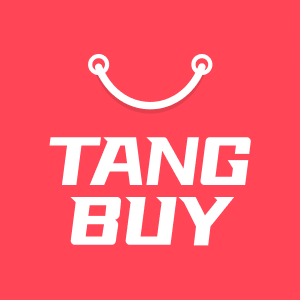Build Your Brand Across Borders with Dropshipping Made Simple

You want to build your brand and reach customers everywhere, but high costs and complicated logistics can hold you back. Dropshipping changes the game. It gives you a simple way to sell worldwide, with no need to manage stock or shipping yourself. Have a look at these numbers showing how fast dropshipping is growing:
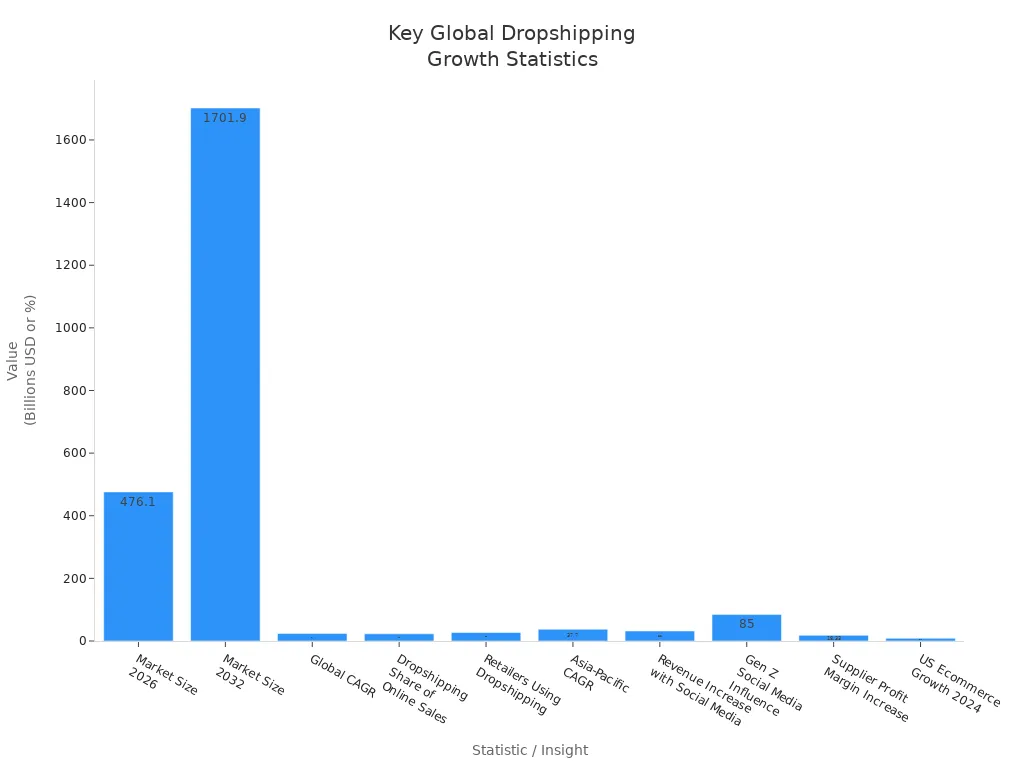
To stand out, you need a strong brand identity, trusted suppliers, and great customer service. Ready to make your mark?
Key Takeaways
Dropshipping lets you sell things all over the world. You do not need to keep any stock. This helps you save money and lowers your risks.
Pick suppliers you can trust. Use automation tools to help with orders, stock, and customer service. This makes your work easier and faster.
Make your brand strong by using the same logos, colours, and messages. This helps customers trust you more.
Change your marketing and support to match each country. Use the right language, culture, and follow local laws.
Pick e-commerce platforms and payment gateways that many people use. Make sure they work with different currencies and languages.
Give users a good experience with a fast website. Show clear product details and make checkout simple. This helps you sell more.
Suggest related products to your customers. This can make them buy more and feel happier with their orders.
Watch important numbers like sales, conversion rates, and feedback. This helps you make your business better and grow.
Is Global Dropshipping Effective?

Advantages
You want to grow your brand but do not want big costs. You also do not want lots of unsold stock. Dropshipping helps with this problem. You can sell many products to people in different countries. You do not need to buy stock before you get a sale. This lets you try new ideas and add products with little risk. You can also reach new places easily.
Here is why global dropshipping is a good choice:
You do not need a warehouse or storage.
You can grow fast by adding products and selling in new countries.
Marketplaces like Shopify and AliExpress help you reach many customers.
Automation tools help you with orders, stock, and customer service. You can spend more time growing your brand.
You can build trust by working with good suppliers. Customer reviews and social media also help.
Marketplaces give you useful data to make your plan better.
You can make your brand stand out with logos, colours, and messages. Social media like Instagram and TikTok help you share your story. You can also work with influencers and use content marketing. This helps more people trust you and know your brand.
Misconceptions
You may have heard some wrong ideas about dropshipping. Let us explain the truth:
Some people think dropshipping makes you rich fast. It really takes time and hard work.
Some think you do not need to register your business. It is easy to start, but registration builds trust.
Many believe dropshipping is always easier and cheaper than a real shop. You still need to spend money on your website, marketing, and customer support.
Not everyone gets success right away. You must try things and see what works for your brand.
Some worry new shops will not get sales. Customers care about good products and reviews, not just how old your shop is.
You do not need to know coding. Platforms make it easy to set up your shop.
Delivery does not always take a long time. Good partners can deliver in a few days.
Import taxes do not always happen. Many countries let customers buy without extra fees.
Market Potential
The global dropshipping market is growing fast. Look at these numbers:
Metric | Value / Insight |
|---|---|
Market Size 2023 | |
Projected Market Size 2033 | USD 2,783.7 Billion |
CAGR (2024-2033) | 25.5% |
Asia Pacific Market Share 2023 | 34.2% |
North America Market Share 2024 | ~33% |
Largest Product Segment 2024 | Fashion (34%+ revenue share) |
Key Growth Drivers | Low capital, scalability, automation, fast delivery, e-commerce growth |
Dropshipping is not just a passing trend. It is a real way to build your brand in many countries. You can find new customers and grow your business. With a good plan, you can join this big market and make your brand global.
How Dropshipping Works
The Model
Dropshipping makes it easy to sell things online. You do not need to keep stock or pack orders yourself. Here is how it works:
You choose a dropshipping supplier who keeps the products for you.
You make an online shop and show the supplier’s products with your prices.
A customer buys something and pays you on your website.
You send the order to your supplier. Many websites do this step for you.
The supplier packs and sends the product straight to your customer. Sometimes, they use your brand on the box.
Your customer gets the product. You answer any questions or help if needed.
Tip: Automation tools help you with orders, stock, and deliveries. This saves time and helps you make fewer mistakes.
You never have to touch the product. You spend your time on marketing and helping customers. You also work on building your brand. The supplier does the rest of the work. This way, you can try new ideas and add products fast, without big risks.
International vs Domestic
Selling to other countries with dropshipping is a bit harder. You must think about more than just sending packages. International dropshipping means you deal with customs, taxes, and different rules in each country. You also have longer shipping times and more suppliers.
Here are some main differences:
International dropshipping often uses many suppliers from different countries. Domestic dropshipping usually has one local supplier.
Shipping takes longer for international orders. Customs and distance can slow things down.
You must follow each country’s laws and safety rules. These rules can change, so you need to check them often.
Payments are harder. You need to take different currencies and handle exchange rates.
Language and culture are important. You may need to translate your website and change your marketing for each country.
Customer service must work in different time zones. Chatbots and email support help you stay open.
Note: International dropshipping needs strong packaging and good delivery companies. This stops damage and keeps customers happy.
Domestic dropshipping is easier. You get faster shipping, better quality checks, and easier returns. But it can cost more because local products and storage are often more expensive. International dropshipping gives you more products and lower costs, but delivery takes longer and the process is harder.
You can use technology to help with these problems. Tools help you manage different money, languages, and time zones. You can also give electronic invoices and order tracking. Clear return rules and local return places make customers feel safe, even if they live far away.
Niche Selection
Global Demand
Choosing the right niche is the first big step in building your dropshipping brand. You want a niche that people all over the world want, not just in one country. Start by thinking about what excites you. If you care about your products, you will find it easier to connect with your customers.
Here are some things to look for when picking a niche with global demand:
High demand but low competition. You want lots of buyers, but not too many sellers.
Products that solve a problem or make life easier. These often sell well everywhere.
Trends that keep growing, not just a quick fad.
Items that are easy to ship and not too expensive.
Products that do not break easily or have lots of rules in different countries.
Tip: Stay updated with trends and keep checking what customers want. Use automation tools to help you manage your shop and focus on growing your business.
You can also look at your own interests and skills. If you know a lot about a topic, you can talk about it better and help your customers more. This makes your brand stronger and more trusted.
Market Research
Once you have some ideas, you need to check if people really want these products. Market research helps you see what is popular and what your competition looks like.
Here are some top tools and methods to help you:
Google Keyword Planner: Check how many people search for your product. Look at keywords, locations, and how hard it is to rank.
Google Trends: See if interest in your niche is growing or falling. You can also check which countries search for your product the most.
Facebook Audience Insights: Find out who your audience is, where they live, and what they like.
AliExpress Dropshipping Center: Spot trending products and see where buyers come from.
Amazon and eBay: Look at bestsellers and completed listings. This shows what is selling right now.
Product Research Tools: Try Jungle Scout, Helium 10, or AutoDS Winning Products Hub. These tools show sales numbers, profit margins, and what your competitors are doing.
Social Media: Watch hashtags, influencer posts, and comments. You can spot new trends before they get big.
Note: Always check more than one source. If a product is popular on Google, Amazon, and Facebook, you know it has real demand.
You can also ask your customers what they want. Use surveys or feedback forms. Keep an eye on your sales data and website traffic. This helps you see what works and what does not.
Tool/Method | What It Does |
|---|---|
Google Trends | Shows search interest over time and by place |
AliExpress Dropshipping | Finds trending products and suppliers |
Facebook Audience Insights | Reveals audience details and interests |
Jungle Scout/Helium 10 | Analyses sales, profit, and competition |
Keep testing and learning. The best niches change over time. If you stay curious and use the right tools, you will always find new chances to grow your brand.
Suppliers
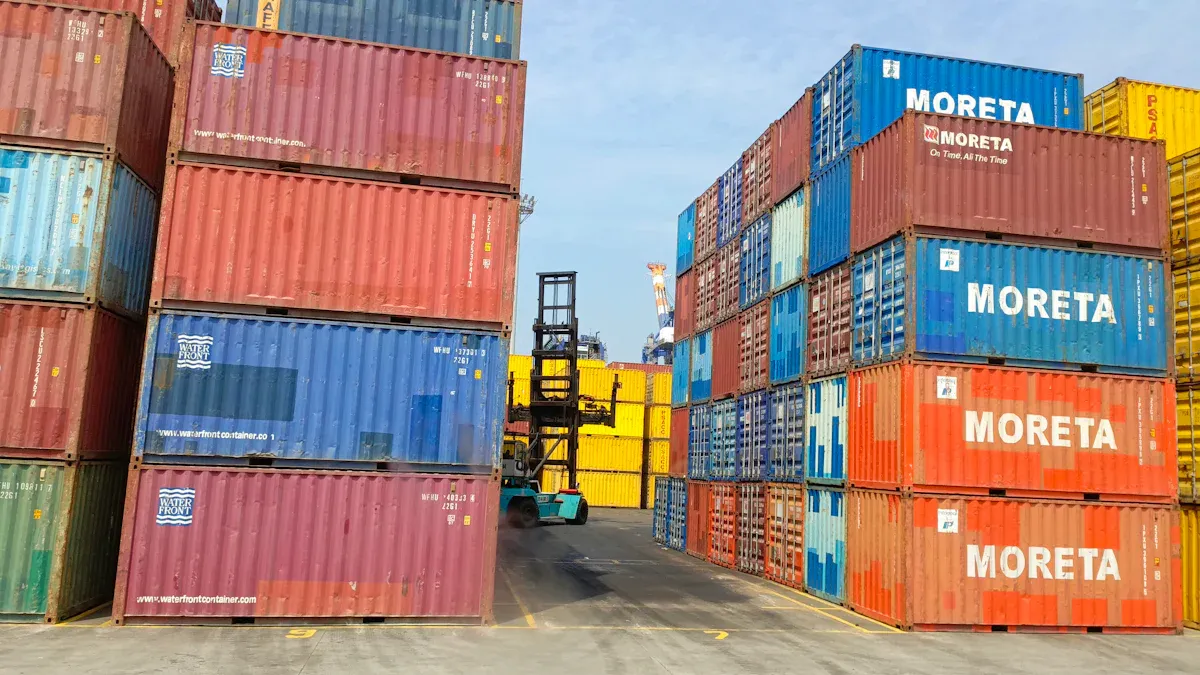
Finding Partners
Picking the right suppliers is very important. Good partners help your business grow. They send quality products and keep their promises. They also help your brand look good. Here are things to check when you choose international suppliers:
Factor | Explanation |
|---|---|
Happy customers buy again. Always ask for samples first. | |
Orders arrive on time. Check reviews and ratings from other people. | |
Competitive Pricing | You can earn more money. Compare prices and watch for hidden fees. |
Shipping Times & Policies | Fast shipping makes customers return. Look at delivery times and tracking. |
Customer Support & Communication | Quick help fixes problems fast. Test how fast they reply and what support they give. |
Legal Compliance | Stops legal trouble. Make sure suppliers follow export and safety rules. |
Integration Capabilities | Easy links with your shop save time. Check if they work with Shopify, WooCommerce, or your platform. |
You should also:
Look at supplier reputation on social media and review sites.
Ask for samples to check product quality yourself.
Make sure they follow all legal rules, like safety and copyright.
Confirm they can ship worldwide and handle customs.
See if they give real-time stock updates and order automation.
Compare prices and look for bulk discounts.
Tip: Good communication matters a lot. If a supplier answers quickly and clearly, you can fix problems early.
Logistics
International dropshipping has extra problems. Shipping can take longer and cost more. You need to plan so customers stay happy.
Common logistics problems are:
High shipping costs in some countries.
Trouble with returns and refunds.
Supplier mistakes or slow replies.
Payment problems with different currencies.
Language or culture misunderstandings.
You can solve these by:
Working with trusted logistics partners to cut delays.
Setting up return hubs for easy refunds.
Using automated tools for customs paperwork and tracking.
Translating your shop for local customers.
Picking e-commerce platforms that link with suppliers and track stock.
Focusing on markets where you can ship fast and cheap.
Giving clear shipping policies and real-time tracking to build trust.
Note: Watch your shipping data. If deliveries are slow, talk to your supplier or change partners.
Customs
Customs rules can be hard, but you can handle them. Always declare products correctly to avoid fines or delays. Use the right HS Code for each item. This helps customs know what you are shipping and how much tax to charge.
Most of the time, your customer pays duties and taxes unless you use Delivered Duty Paid (DDP) shipping. Make sure your packaging follows local rules, like language and safety labels. Work with fulfilment centres that know customs laws in your target countries.
Returns can be tricky. Sometimes, you pay extra duties to bring items back. Give clear return policies and prepaid labels to make things easier. Stay updated on customs changes and use brokers or automated tools to keep your business legal.
Callout: Always tell your customers about possible customs fees. Being honest builds trust and stops surprises.
If you learn about customs and plan ahead, you can ship worldwide with fewer problems and happier customers.
Build Your Brand
You want people to remember your business, trust it, and choose it over others. When you build your brand, you create a story that connects with customers everywhere. Let’s look at how you can make your brand strong and recognisable across borders.
Brand Identity
Your brand identity is more than a logo or a name. It’s the feeling people get when they see your shop or buy your products. You need to show who you are and what you stand for. Here’s how you can build your brand identity step by step:
Define your mission and core values. What do you believe in? What makes your business special?
Understand your customers. Research your audience and create buyer personas. This helps you speak their language and meet their needs.
Choose your colours, logo, and style. Pick a colour palette and design a simple logo that people remember. Use the same style everywhere.
Set clear brand guidelines. Make rules for your logo, colours, and tone of voice. This keeps your brand consistent on every platform.
Tip: Consistency builds trust. If your brand looks and sounds the same everywhere, people feel safe buying from you.
A strong brand identity helps you stand out in a busy market. Customers trust brands that feel real and honest. In fact, nearly half of shoppers say they spend more with brands they trust. When you build your brand with care, you create loyal fans who come back again and again.
Visuals & Messaging
You want your brand to catch people’s eyes and make them feel something. Good visuals and clear messaging help you do this. When you sell to different countries, you need to think about culture and language.
Use high-quality images that show your products clearly. Make sure your pictures fit the style and taste of your audience.
Write short, clear messages that focus on benefits. Tell people how your product solves their problems.
Add strong calls to action. Use phrases like “Shop Now” or “Limited Time Offer” to encourage quick decisions.
Show social proof. Share reviews or testimonials to build trust.
Test different ads and messages. Try new headlines, images, and offers. See what works best for each country.
Avoid misleading pictures or claims. Stay honest and follow the rules of each platform.
Note: Personalised ads work better. If you know your audience well, you can create messages that feel special to them.
You can use visuals to tell your brand story. Show your products in action. Use colours and styles that match your brand identity. Keep your messages simple and easy to read. When you build your brand with strong visuals and clear words, you connect with people all over the world.
Visuals & Messaging Tips | Why It Matters |
|---|---|
High-quality, relevant images | Builds trust and grabs attention |
Benefit-focused ad copy | Shows value and solves problems |
Clear calls to action | Drives sales and engagement |
Social proof (reviews, ratings) | Increases credibility |
Testing and optimisation | Improves results in each market |
Print-on-Demand
Print-on-demand (POD) lets you create custom products without holding stock. You can design items that show off your brand style and values. This helps you build your brand and stand out from other shops.
Add your logo, colours, or special messages to products. Make your items unique.
Offer personalisation. Let customers choose colours, sizes, or add their names. People love products made just for them.
Use POD to launch limited editions or seasonal items. Create excitement with “last chance” sales.
Work with reliable POD suppliers. Fast shipping and good quality keep customers happy.
Share your designs on social media. Tell your brand story and show what makes your products special.
Automate order processing with fulfilment software. This saves time and reduces mistakes.
Callout: Personalised products make customers feel valued. They are more likely to buy again and tell friends about your shop.
POD helps you avoid price wars. You offer exclusive designs that people cannot find anywhere else. Customers see your brand as creative and high-quality. When you build your brand with POD, you create loyal fans who love your unique style.
You can use POD to grow your business in new countries. Local suppliers can ship faster and offer better service. Your brand becomes known for special products and great customer experience.
If you want to build your brand across borders, focus on identity, visuals, and custom products. These steps help you connect with customers, earn their trust, and grow your business worldwide.
E-Commerce Setup
Platform Choice
Picking the right e-commerce platform makes dropshipping much easier. You need a platform that helps you sell to people everywhere. It should also be simple for you to use. Here are some top choices for international dropshipping:
Shopify is simple to use. It supports many languages and works with dropshipping apps.
Magento is good for bigger shops. It has strong security and many custom features.
WooCommerce is great if you use WordPress. It is flexible and has lots of plugins.
Amazon Marketplace lets you reach many buyers in different countries.
These platforms are popular because they give you:
Support for many languages, so you can sell worldwide.
Designs that work well on phones, so people can shop anywhere.
Strong security, like two-factor login.
Payment options that handle many currencies.
Tools for shipping and fast delivery.
Easy links to dropshipping suppliers and apps.
Customer service tools for different languages and cultures.
Tip: Choose a platform that fits your business size and goals. Start small and grow bigger as your shop gets more sales.
Payments & Currencies
You want customers to pay easily, no matter where they live. The right payment gateway lets you take payments in many currencies and keeps them safe. Here are some top choices:
Payment Gateway | Countries Available | International Fees | Supported Currencies |
|---|---|---|---|
PayPal | 200+ | 2.9% + $0.25 | 25+ |
Stripe | 135+ | 2.9% + $0.25 | 135+ |
Amazon Pay | 18 | 3.9% + $0.30 | 12 |
2Checkout | 200+ | 3.5% + $0.30 | 100+ |
Adyen | 38 | $0.10 + variable | 30+ |
Apple Pay | 70 | 1.5% + $0.25 | 70+ |
Braintree | 40+ | N/A | 130+ |
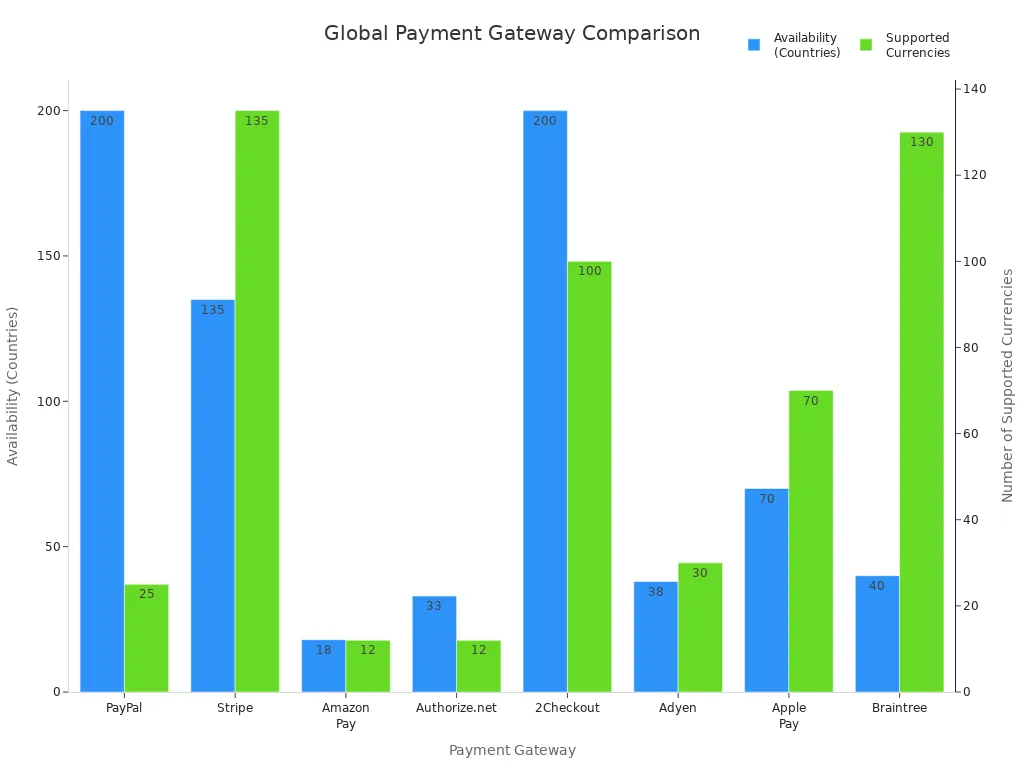
Look for gateways that have:
Support for many currencies, so customers see prices in their own money.
Strong security, like encryption and fraud checks.
Easy links to your e-commerce platform.
Fast and helpful support in different languages.
Note: Stripe and PayPal are favourites because they work in many countries and support lots of currencies.
User Experience
A smooth shopping experience makes customers want to return. Your shop should be easy, quick, and friendly for everyone.
Make your website work well on phones. Most people shop on their mobiles now.
Add customer reviews. People trust what others say before buying.
Use wish-lists. Customers can save items and come back later.
Offer product filters. Help people find what they want fast.
Keep checkout simple. Fewer steps mean fewer people leave their carts.
Use clear, high-quality product images. Good pictures help people choose.
Give quick support. Offer chat, email, or phone help in different languages.
Make your site load fast. A quick site means more sales.
Callout: A great user experience builds trust and helps your brand stand out everywhere.
With the right platform, payment choices, and user experience, you can welcome customers from all over the world and grow your dropshipping brand with confidence.
Marketing
Localisation
If you want your dropshipping brand to do well in other countries, you must localise your marketing. Localisation means changing your shop, products, and ads for each country. You do not just translate your website. You also change your words, pictures, and deals to fit what people like in each place.
Here are some smart ways to localise your dropshipping business:
Choose products that fix problems in your target country. Pick things that match what people there like.
Work with suppliers who deliver fast and give good service in your chosen country.
Set prices that cover your costs and match what locals expect. Check what your rivals charge.
Study your rivals. See what works for them and find ways to be different.
Learn about local culture and what customers want. Some people want fast shipping, others care more about price.
Give customer support in the local language. This helps people trust you and feel welcome.
Change your products to fit local tastes. Use local suppliers if you can to make shipping faster.
Follow local laws, like GDPR in the UK, to keep your business safe.
Use payment methods that are popular in each country, like mobile wallets or cash-on-delivery.
Work with local fulfilment centres to make returns and delivery easier.
Use ePacket delivery for quicker shipping in many places.
Run ads on social media that are popular in your target country.
Tip: Always think about your customer first. If you know what they need and like, you will build loyal fans.
Global Marketplaces
Selling on global marketplaces helps you reach lots of buyers. You can list your products on sites like Amazon, eBay, Alibaba, AliExpress, Walmart, Jumia, and Mercado Libre. Each site has its own rules, so you need to learn how they work.
To get the most from these marketplaces, you should:
Read and follow each marketplace’s rules. This keeps your shop safe from bans.
Make sure your products are allowed and meet quality standards.
Manage your stock carefully. Use tools to track inventory and avoid running out.
Sell on more than one marketplace if you can. This helps you reach more customers.
Use ERP systems to handle orders and stock across all platforms.
Work with tech partners who offer automation and data tools. These help you make smart decisions and grow faster.
Note: Automation saves time and helps you keep up with orders, especially when you sell in many countries.
Social Media
Social media is a strong tool for dropshipping brands. Over 5.22 billion people use social media around the world. More than half of users check products before buying, and 71% trust tips from social media.
You can use different platforms to reach your audience:
Platform | User Base (approx.) | Key Advantages for Dropshipping Promotion |
|---|---|---|
Build communities, share updates | ||
1 billion | Show off products with images and videos | |
1 billion | Create short, fun videos, work with influencers | |
YouTube | 2.6 billion | Share tutorials and product demos |
431 million | Post evergreen, visual content | |
330 million | Give quick updates and engage followers |
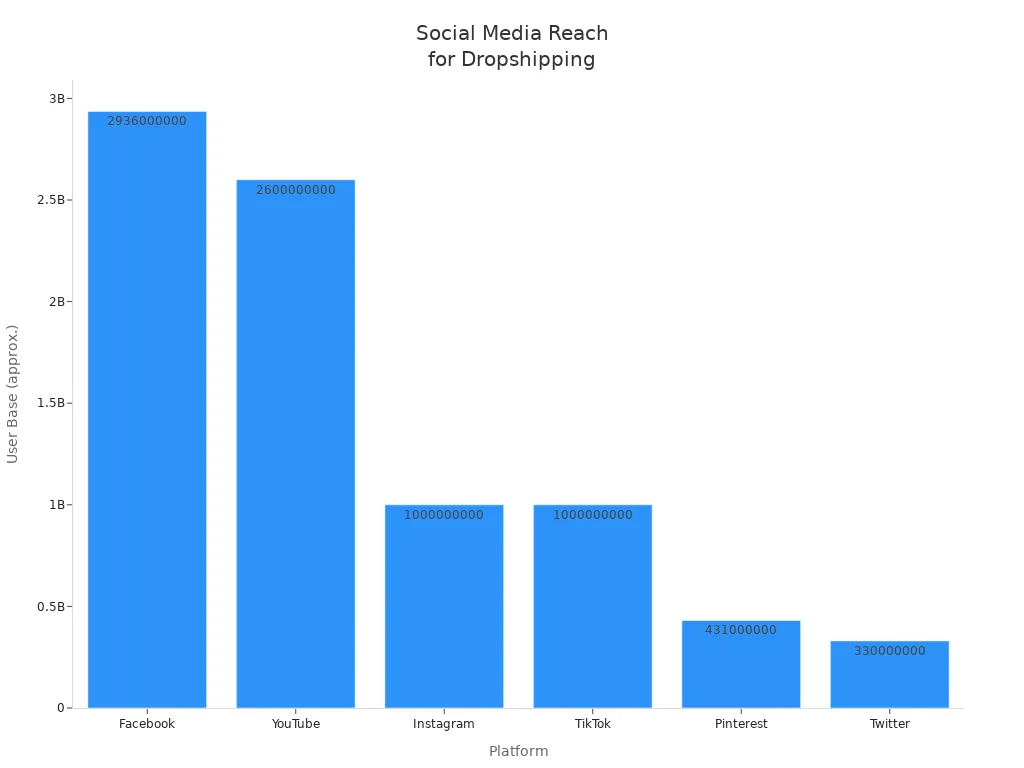
Instagram and TikTok are great for showing products in action. Videos get shared more than text or pictures. Facebook helps you make groups and talk to fans. YouTube is good for longer videos and how-to guides. Pinterest works well for fashion and lifestyle brands. Twitter lets you chat with customers and share news.
Callout: Try working with influencers, especially on TikTok and Instagram. Their followers trust them and like finding new products.
If you use social media well, you can build a strong brand and reach customers everywhere.
Cross-Selling
Cross-selling is a smart way to boost your dropshipping sales and make your customers happier. When you use cross-selling, you suggest extra products that go well with what someone is already buying. This can turn a simple order into a bigger one, and it shows your customers that you understand what they need.
Imagine a customer adds a phone to their basket. You could show them a screen protector or a stylish phone case. These small add-ons make shopping easier for your customer and help you earn more from each sale. You do not need to push too hard. Just offer helpful ideas at the right time.
Tip: Use a “You May Also Like” section on your product or checkout pages. This makes it easy for shoppers to see what else they might want.
Personalisation is key. If you know what your customer likes, you can suggest products that fit their style or needs. For example, a fashion shop might show “Styled with” outfits to help customers build a complete look. This feels helpful, not pushy.
Here are some ways you can use cross-selling in your dropshipping shop:
Show related products on product pages or during checkout.
Use automated tools to suggest items based on what the customer has viewed or bought before.
Send post-purchase emails with special offers or new product ideas. This keeps your brand in their mind and brings them back for more.
Offer bundles or sets at a small discount. People love getting a deal, and it helps them try more of your products.
Cross-Selling Method | How It Helps Your Brand |
|---|---|
Personalised suggestions | Makes shopping feel special |
Complementary products | Increases order value |
Post-purchase emails | Brings customers back |
Bundles and sets | Boosts sales and customer satisfaction |
Cross-selling does more than just raise your average order value. It builds trust and loyalty because you show that you care about your customers’ needs. You also save money, as you earn more from each customer without spending extra on ads.
Automated tools and AI can help you set up cross-selling with little effort. These tools watch what your customers do and suggest the right products at the right time. This means you can focus on growing your brand while your shop works smarter for you.
Note: Always keep your suggestions relevant and timely. If you offer the right product at the right moment, your customers will thank you—and so will your bottom line.
Cross-selling is not just about making more money. It is about giving your customers a better, more flexible shopping experience. When you get it right, everyone wins.
Operations
Shipping & Returns
Shipping and returns are very important for your dropshipping brand. This is even more true when you sell to other countries. You want customers to feel safe buying from you, even if they live far away. But sending things overseas can be tricky. Here are some common problems and ways to fix them:
Challenge | Description | Solution |
|---|---|---|
High international return shipping costs and delays | Sending returns back from other countries costs a lot and takes time. | Use third-party logistics (3PL) for local return addresses. Give store credits instead of making customers send things back. |
Disputes over product quality and return responsibilities | Sometimes, customers and suppliers argue about who is to blame or who pays for returns. | Make clear rules with your suppliers. Keep records and use proof to solve arguments. |
Balancing customer satisfaction with profitability | Free returns can make you lose money. | Make clear return rules. Offer part refunds or store credits. Make your product pages better to stop returns. |
Complex return logistics | Returns and swaps can get confusing. | Use software to make returns easier. Always talk clearly with your customers. |
Supplier inflexibility on returns | Some suppliers do not take returns or are slow to process them. | Pick suppliers with good return rules and clear terms. |
You can also lower returns by giving true product details, using clear photos, and adding size charts. Test samples before you sell them. Make your return policy easy to find and simple to read. Always follow the rules in each country about returns and refunds. If you do these things, people will trust you and stay happy.
Tip: Always tell the truth about shipping times and any extra fees. Customers like clear info and will buy from you again.
Customer Support
Good customer support makes your brand special. If you sell worldwide, you must help people in many languages and time zones. Multilingual support helps more people and makes them feel welcome.
Multilingual support lets you talk to customers in their own language.
It helps customers feel welcome and understood.
Your brand looks more professional and caring.
You get ahead of shops that only use one language.
Clear talk means fewer mistakes and more sales.
Here is how you can build strong multilingual support:
Check which languages your customers use. Look at your website and social media to see trends.
Hire support agents who speak local languages and know the culture. Train them often.
Use AI chatbots that translate messages right away. This gives quick help, even when your team is not online.
Make FAQs, guides, and tutorials in different languages. Update them often so customers can fix problems themselves.
Tell customers when they will get a reply. Match your support hours to their time zones and use auto-replies if needed.
Offer help through live chat, email, phone, social media, and self-service portals. Let customers pick what works best for them.
Keep checking your support quality. Ask for feedback and make changes to get better.
Callout: Customers remember how you treat them. Fast, friendly help in their own language keeps them coming back.
Compliance
Running a global dropshipping business means you must follow many rules. Each country has its own laws about data, taxes, ads, and products. If you ignore these, you could get fined or lose your shop.
Protect customer data and follow privacy laws like GDPR. Use safe payment systems and get clear consent for data use.
Tell customers and authorities quickly if there is a data breach.
Follow ad rules. Do not use fake ads or reviews. Always show terms, fees, and return rules clearly.
Learn about VAT, GST, and other taxes in each country. Register for tax IDs and collect the right taxes.
Check customs and import duties. Tell customers about any extra fees before they buy.
Do not sell banned or restricted products. Always check local rules before selling new items.
Respect trademarks, copyrights, and patents. Only use images and product details you have rights to.
Work with suppliers who follow the law. Sign contracts that explain who does what.
Get the right business licences and permits. This makes your shop look trustworthy.
Use safe payment gateways that meet local rules, like PSD2.
Stay up to date with changing laws. Talk to legal experts if you are not sure.
Note: Clear, honest talk and strong legal rules protect your brand and help you grow safely in new places.
Automation
Running a dropshipping business across borders can feel overwhelming. You have orders to process, customers to help, and suppliers to manage. Automation makes your life much easier. It helps you do more in less time and keeps your business running smoothly, even when you are asleep.
You can use automation tools for many daily tasks. These tools handle things like order processing, stock updates, and customer emails. You do not need to check every order by hand. The system sends orders to your suppliers and updates your customers with tracking numbers. This means fewer mistakes and faster service.
Virtual assistants (VAs) are also a big help. They take care of jobs that you do not have time for. Here is what VAs can do for your dropshipping shop:
Research trending products using tools like Google Trends.
Talk to suppliers, negotiate prices, and solve problems.
Process orders and track deliveries.
Keep your stock levels updated to avoid running out.
Answer customer questions and handle refunds.
Manage your social media and run ad campaigns.
Help with legal checks and make sure you follow the rules.
Give you reports and data to help you make better decisions.
Support your business in different languages and markets.
Tip: Hiring VAs costs less than hiring full-time staff. You can add more VAs as your business grows, so you stay flexible.
Let’s look at how automation and VAs work together to boost your business:
You set up automation platforms like AutoDS or Oberlo. These tools connect your shop with suppliers and handle orders.
You give your VAs access to these platforms. They get task-specific permissions, so your data stays safe.
VAs list new products, update SEO, and keep your shop fresh.
They manage customer support, answer emails, and solve problems quickly.
VAs run your marketing, schedule posts, and send out emails to your customers.
You use tools like Trello or Slack to keep everyone on the same page.
Task | Automation Tool | VA Role |
|---|---|---|
Order Processing | AutoDS, Oberlo | Check and confirm |
Inventory Updates | Shopify Apps | Monitor and report |
Customer Support | Chatbots | Personal replies |
Marketing | Email Tools | Social media posts |
Compliance | Alerts | Legal checks |
Note: Automation does not replace people. It helps your team work faster and smarter. You get more time to plan, grow, and build your brand.
With the right mix of automation and VAs, you can scale your dropshipping business without losing control. You stay focused on what matters most—growing your brand and keeping your customers happy.
Performance
Metrics
You want to know if your dropshipping brand is doing well. Tracking the right numbers helps you see what works and what needs fixing. Here are the key metrics you should watch:
Total Sales and Revenue – This shows how much money your shop brings in. You can spot trends and set goals.
Average Order Value (AOV) – This tells you how much customers spend each time they buy. If you want bigger orders, try bundles or cross-selling.
Conversion Rate – This is the percentage of visitors who buy something. A higher rate means your website and ads are working.
Customer Acquisition Cost (CAC) – This shows how much you spend to get a new customer. Lower costs mean your marketing is smart.
Return on Ad Spend (ROAS) – This tells you how much money you make for every pound spent on ads. For example, if you improve your ads and target the right people, you might see your ROAS jump to 4.5x.
Customer Lifetime Value (CLV) – This is the total money you expect from a customer over time. Loyal customers are worth more.
Fulfilment and Shipping Times – Fast delivery keeps customers happy and brings them back.
Order Accuracy Rate – Fewer mistakes mean fewer refunds and better reviews.
Refund and Return Rates – High rates can show problems with product quality or descriptions.
Customer Satisfaction and Reviews – Good reviews build trust and help your brand grow.
Tip: Keep an eye on these numbers every week. Use them to make smart choices and spot problems early.
Feedback
Listening to your customers helps you improve. You can collect feedback in many ways:
Use feedback tools like Famewall to make it easy for customers to share their thoughts.
Send out short surveys after a purchase. Offer a small discount to encourage replies.
Watch social media and forums for honest opinions about your shop.
Check call logs and support chats for common questions or complaints.
Try user testing to see where people get stuck on your website.
Platforms like Zigpoll let you ask customers about their experience right after they buy. You can learn if your packaging is good or if your marketing feels honest. When you use this feedback, you can fix problems, improve your products, and make your brand more trustworthy. Show off good reviews on your website to build trust with new shoppers.
Note: Honest feedback helps you grow. Use it to make changes that matter to your customers.
Scaling
Ready to take your brand to new countries? Scaling your dropshipping business means reaching more people and growing your sales. Here are some smart ways to do it:
Offer prices in different currencies so customers feel at home.
Translate your website, ads, and emails to match local languages.
Research what products are popular in each country.
Work with shipping partners who deliver quickly and reliably.
Be clear about taxes and customs fees at checkout.
Use global marketplaces like Amazon or eBay to test new markets.
Give customers payment options they know and trust.
Start small in each new country. Test your products and marketing before going big.
Provide great customer service and clear communication to build trust.
Callout: When you adapt to local needs and keep your service top-notch, your brand can grow in any market.
You now have the tools to build your brand across borders with dropshipping. Focus on a strong brand identity, choose reliable suppliers, and give your customers a great experience. Try out the strategies you have learned here. If you want to learn more, check out online courses or join dropshipping communities. Start today and see how far you can go!
FAQ
What is dropshipping in simple terms?
You sell products online, but you do not keep them in stock. When someone buys from your shop, your supplier ships the item straight to your customer. You never handle the product yourself.
Can I start dropshipping with little money?
Yes, you can. You do not need to buy stock upfront. You only pay your supplier after you get a sale. You will need some money for your website, marketing, and a few tools.
How do I find good suppliers for my shop?
Look for suppliers with good reviews and fast replies. Always order samples to check quality. Use trusted platforms like Tangbuy,AliExpress, Oberlo, or Spocket. Good suppliers help your brand grow.
Will my customers know I use dropshipping?
Most customers will not know. Many suppliers offer “blind shipping,” which means they do not include their name or logo. You can also add your branding to packaging with some suppliers.
How do I handle returns and refunds?
Set clear return rules on your website. Work with suppliers who accept returns. Offer store credit or refunds if needed. Use local return addresses when possible. Good communication helps solve problems quickly.
Is dropshipping legal in every country?
Dropshipping is legal in most places. You must follow local laws, pay taxes, and avoid selling banned items. Always check the rules in each country where you want to sell.
How long does international shipping take?
Shipping times depend on the supplier and country. Most orders arrive in 7–21 days. Some suppliers offer faster options. Always tell your customers how long delivery will take.
Can I build a real brand with dropshipping?
Yes, you can. Focus on your brand’s look, message, and customer service. Use custom packaging or print-on-demand products. Happy customers and strong branding help your shop stand out.

TangBuy: A Smarter Way to Dropship in 2025
If you're looking to stay competitive with dropshipping in 2025, speed and trend-awareness are key. TangBuy helps you stay ahead with real-time product trends, fast fulfilment, and factory-direct sourcing. With over 1 million ready-to-ship items, 24-hour order processing, and seamless Shopify integration, TangBuy makes it easier to test, scale, and succeed in today's fast-moving eCommerce landscape.
See Also
How To Start A Successful Dropshipping Venture In 2025
Profitable Dropshipping Concepts To Explore For 2025 Earnings
Easy Ways To Earn Through eBay Dropshipping In 2025
Starting Shopify Without Dropshipping: A Beginner’s 2025 Guide
Comprehensive Guide To Online Wholesale Selling In The Year 2025
